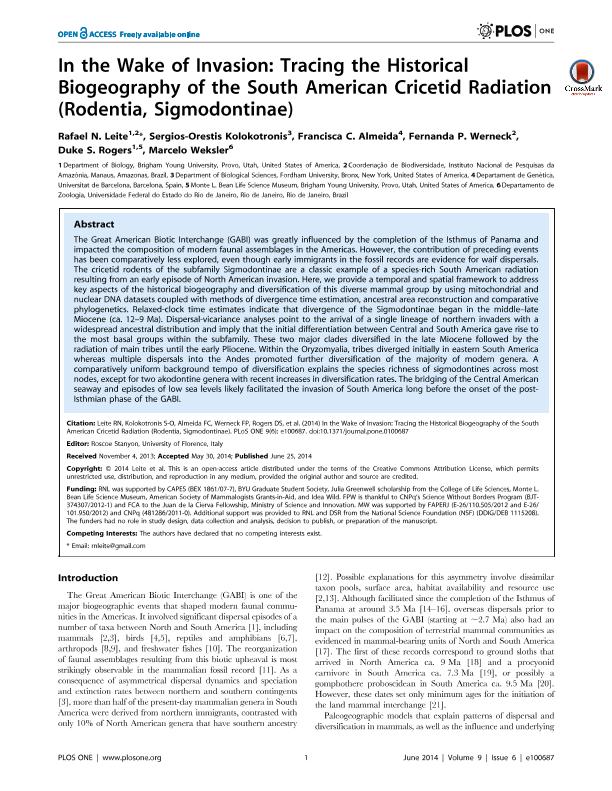Mostrar el registro sencillo del ítem
dc.contributor.author
Leite, Rafael N.
dc.contributor.author
Kolokotronis, Sergios Orestis
dc.contributor.author
Cunha Almeida, Francisca

dc.contributor.author
Werneck, Fernanda P.
dc.contributor.author
Rogers, Duke S.
dc.contributor.author
Weksler, Marcelo
dc.date.available
2019-10-02T21:42:58Z
dc.date.issued
2014-06
dc.identifier.citation
Leite, Rafael N.; Kolokotronis, Sergios Orestis; Cunha Almeida, Francisca; Werneck, Fernanda P.; Rogers, Duke S.; et al.; In the wake of invasion: Tracing the historical biogeography of the South American cricetid radiation (Rodentia, Sigmodontinae); Public Library of Science; Plos One; 9; 6; 6-2014; 1-12; e100687
dc.identifier.uri
http://hdl.handle.net/11336/85101
dc.description.abstract
The Great American Biotic Interchange (GABI) was greatly influenced by the completion of the Isthmus of Panama and impacted the composition of modern faunal assemblages in the Americas. However, the contribution of preceding events has been comparatively less explored, even though early immigrants in the fossil records are evidence for waif dispersals. The cricetid rodents of the subfamily Sigmodontinae are a classic example of a species-rich South American radiation resulting from an early episode of North American invasion. Here, we provide a temporal and spatial framework to address key aspects of the historical biogeography and diversification of this diverse mammal group by using mitochondrial and nuclear DNA datasets coupled with methods of divergence time estimation, ancestral area reconstruction and comparative phylogenetics. Relaxed-clock time estimates indicate that divergence of the Sigmodontinae began in the middle-late Miocene (ca. 12-9 Ma). Dispersal-vicariance analyses point to the arrival of a single lineage of northern invaders with a widespread ancestral distribution and imply that the initial differentiation between Central and South America gave rise to the most basal groups within the subfamily. These two major clades diversified in the late Miocene followed by the radiation of main tribes until the early Pliocene. Within the Oryzomyalia, tribes diverged initially in eastern South America whereas multiple dispersals into the Andes promoted further diversification of the majority of modern genera. A comparatively uniform background tempo of diversification explains the species richness of sigmodontines across most nodes, except for two akodontine genera with recent increases in diversification rates. The bridging of the Central American seaway and episodes of low sea levels likely facilitated the invasion of South America long before the onset of the post-Isthmian phase of the GABI.
dc.format
application/pdf
dc.language.iso
eng
dc.publisher
Public Library of Science

dc.rights
info:eu-repo/semantics/openAccess
dc.rights.uri
https://creativecommons.org/licenses/by-nc-sa/2.5/ar/
dc.subject
Sigmodontinae
dc.subject
Great Biotic Interchange
dc.subject
Radiation
dc.subject
Molecular Phylogeny
dc.subject.classification
Zoología, Ornitología, Entomología, Etología

dc.subject.classification
Ciencias Biológicas

dc.subject.classification
CIENCIAS NATURALES Y EXACTAS

dc.title
In the wake of invasion: Tracing the historical biogeography of the South American cricetid radiation (Rodentia, Sigmodontinae)
dc.type
info:eu-repo/semantics/article
dc.type
info:ar-repo/semantics/artículo
dc.type
info:eu-repo/semantics/publishedVersion
dc.date.updated
2019-10-02T20:54:42Z
dc.identifier.eissn
1932-6203
dc.journal.volume
9
dc.journal.number
6
dc.journal.pagination
1-12; e100687
dc.journal.pais
Estados Unidos

dc.journal.ciudad
San Francisco
dc.description.fil
Fil: Leite, Rafael N.. University Brigham Young; Estados Unidos. Ministério da Ciência, Tecnologia, Inovações. Instituto Nacional de Pesquisas da Amazônia; Brasil
dc.description.fil
Fil: Kolokotronis, Sergios Orestis. Fordham University; Estados Unidos
dc.description.fil
Fil: Cunha Almeida, Francisca. Universidad de Barcelona; España. Consejo Nacional de Investigaciones Científicas y Técnicas. Oficina de Coordinación Administrativa Ciudad Universitaria. Instituto de Ecología, Genética y Evolución de Buenos Aires. Universidad de Buenos Aires. Facultad de Ciencias Exactas y Naturales. Instituto de Ecología, Genética y Evolución de Buenos Aires; Argentina
dc.description.fil
Fil: Werneck, Fernanda P.. Ministério da Ciência, Tecnologia, Inovações. Instituto Nacional de Pesquisas da Amazônia; Brasil
dc.description.fil
Fil: Rogers, Duke S.. University Brigham Young; Estados Unidos
dc.description.fil
Fil: Weksler, Marcelo. Universidade Federal do Estado do Rio de Janeiro; Brasil
dc.journal.title
Plos One

dc.relation.alternativeid
info:eu-repo/semantics/altIdentifier/doi/http://dx.doi.org/10.1371/journal.pone.0100687
dc.relation.alternativeid
info:eu-repo/semantics/altIdentifier/url/https://journals.plos.org/plosone/article?id=10.1371/journal.pone.0100687
Archivos asociados
